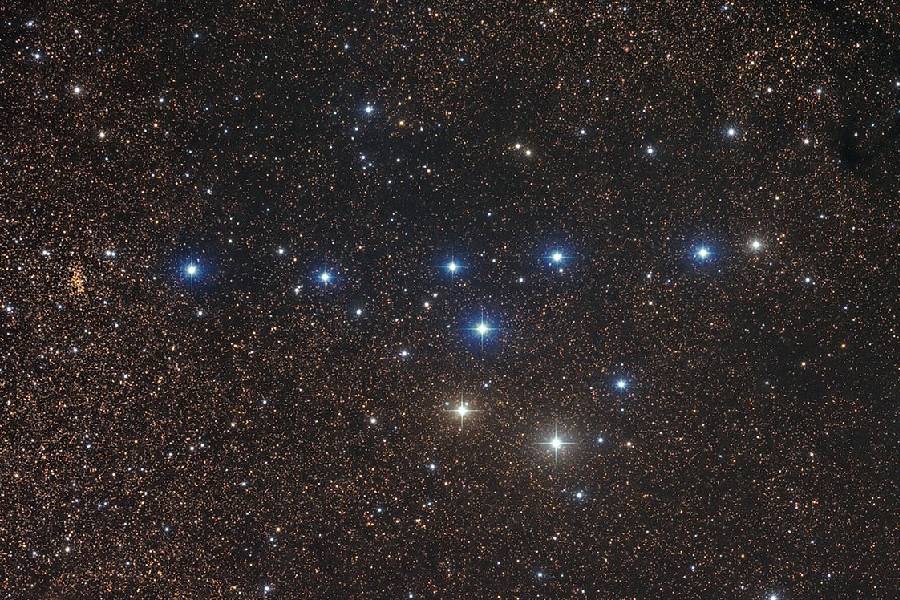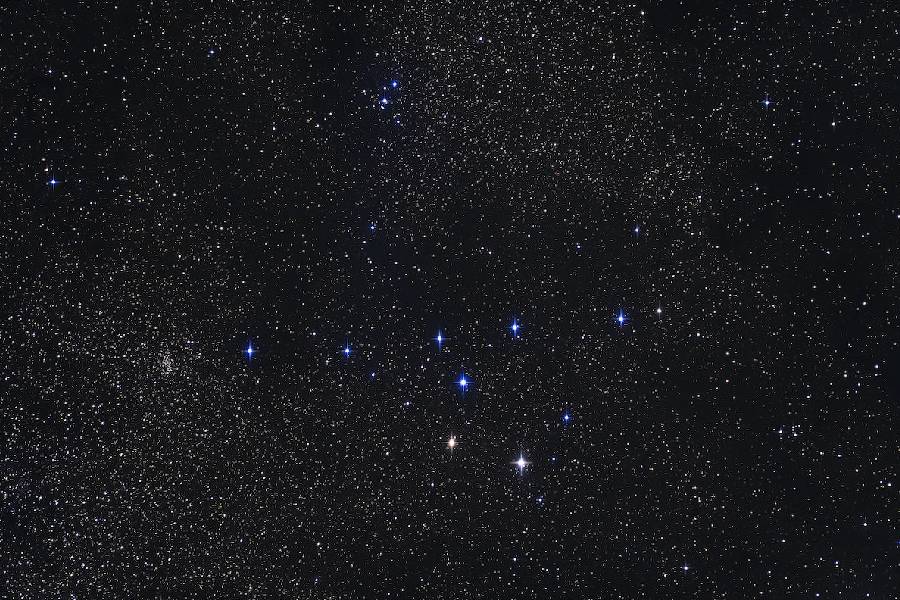Have you ever gazed at the night sky and spotted what looked like a quirky new constellation? What you may have seen is one of the over 50 asterisms that decorate our galaxy. But in astronomy, what are asterisms?
As we traverse the basics about asterisms, we’ll learn their origins, see stellar examples, and find out how to spot these cosmic delights on your own. We’ll also cover why asterisms can make stargazing for beginners more exciting by serving up eye-catching arrangements waiting to be discovered on your next clear night gazing heavenward.
Read on to discover what distinguishes these cosmic gems from the 142 official constellations of the celestial sphere.
What Are Asterisms?
Asterisms refer to recognizable patterns of stars within a constellation that are not formally recognized as constellations. These star patterns are often smaller and more distinctive than the entire constellation and may be composed of stars from different constellations.
Examples of asterisms include the Big Dipper, which is part of the Ursa Major constellation. Another one is the Summer Triangle, formed by stars from three different constellations.
Unlike constellations, asterisms are informal groupings that have cultural or observational significance. They serve as helpful guides for stargazers navigating the night sky.

Asterisms vs. Constellations
Understanding constellations
Constellations are 88 regions that divide up the celestial sphere. Officially designated by the International Astronomical Union, they contain star patterns that help map the positions of stars and deep-sky objects.
Unlike constellations, though, asterisms are informal star patterns layered atop constellations. They have no official boundaries or roles in mapping the skies.
Asterisms as subsets
Many asterisms represent particularly eye-catching segments of larger constellations. For example, the Big Dipper lies fully within the boundaries of Ursa Major. As an asterism, it functions as a “subset” that draws attention thanks to its ladle shape.
Other asterisms, like the Northern Cross, span across parts of Cygnus and graze other constellations. Their lines and angles make them appear to observers as mini star designs inside official constellations.
So, asterisms add decorative flourishes to the grid system of constellations. They contribute variety and visual interest to different regions of the night sky as perceived from Earth. Their inclusion on celestial maps and in sky lore further enriches the tapestry of antiquity passed down through generations of stargazing.
Types of Asterisms
Asterisms come in several broad categories that help observers identify and appreciate them. Some of the major types include:
- Star clusters – Compact groups like the Pleiades or Hyades clusters embedded in the Taurus constellation.
- Segments – Prominent parts of constellations like Orion’s Belt or Scorpius’ curved tail.
- Shapes – Unique outlines like the Northern Cross in Cygnus or the Summer Triangle formed by three stars.
- Pairs – Eye-catching doubles like the Double Cluster in Perseus.
- Rows – Distinctive lines like the three stars forming the Belt of Orion.
Common examples
Well-known cases include the Big Dipper asterism, composed of seven bright stars forming a ladle that guides observers to Polaris, the North Star. Its friendly shape has oriented generations of skywatchers.
Furthermore, the Little Dipper lies across the northern sky from its larger counterpart. Four of its stars belong to the Ursa Minor constellation, while three align with Draco’s tail.
Another famed star row is the three nearly perfectly aligned suns in Orion’s belt. This short, straight row of second-magnitude stars presents an attention-grabbing target as Orion climbs into winter skies.

Famous Asterisms: Icons in the Night Sky
The Big Dipper
Perhaps the most legendary of all star patterns is the Big Dipper, formed by seven bright stars that shape an unmistakable ladle spanning 10 degrees of Ursa Major. Its friendly form has made it a cultural touchstone for Northern Hemisphere civilizations and an enduring introductory sight for novice stargazers.
The Dipper wheels around Polaris throughout the year and seasons clockwise. Its “pointer” stars direct viewers toward Polaris, making it a vital wayfinder. While low in the northern sky, the Dipper gained fame by guiding on the Underground Railroad.
Corona Borealis and Cassiopeia
Another beloved jeweled loop gracing Northern Hemisphere skies is Corona Borealis – the Northern Crown. This semicircular garland of moderately bright suns lies between the Hercules and Boötes constellations. According to the myth, it represents the crown Dionysus gave to Ariadne, which was later memorialized in the stars.
Equally eye-catching is the constellation Cassiopeia, which contains five major stars tracing out a jagged, elongated “W”. Named for a boastful Greek queen, Cassiopeia wheels around Polaris opposite of the Big Dipper. From Canada to New Zealand, this “W” shaped casual circle dazzles observers by standing upright on autumn nights.
Notable Asterisms Worldwide
Australia’s Dreamtime sky
The First Nations people of Australia gazed upon celestial asterisms central to their ancient Dreamtime stories. The Emu in the Sky forms from dark clouds between the Milky Way, representing a great emu that roams the heavens.
The head of Crocodile Sky lies toward Sagittarius and Scorpius while its winding tail migrates between Corona Australis and the M7 open cluster. These patterns link terrestrial lifeforms to the cosmos.
Asian and African star patterns
Asian cultures spotlight the brilliant Summer Triangle of Deneb, Altair, and Vega as the Celestial River. This staple asterism marked planting seasons viewed from China to Vietnam to India during its seasonal appearance. In South Africa, the African Lionesses asterism stretches toward the galactic center in Sagittarius.
Composed of zodiac stars, this pride roams the Milky Way in a revered section of the sky honored by San tribe rock paintings. From Korea’s Dipper stars to the iconic Southern Cross of New Zealand, beloved asterisms worldwide bridge astronomy and culture.
Brightest Stars in Asterisms and Their Spectral Types
Identifying bright stars
The vivid stars forming asterisms showcase a range of brilliance. Sirius appears almost blue-white to the naked eye and dominates in Orion’s Small Dog as the sky’s brightest star. Arcturus glows a crisp orange hue and defines the Spring Triangle along with Spica and Regulus.
The Northern Cross host Deneb sparkles as the 19th brightest star while tailoring the Summer Triangle and Cygnus constellation. Though less bright, products of stellar evolution from red giants like Aldebaran (14th brightest) to blue-white supergiants like Rigel (7th brightest) attract attention by amplifying asterisms.
Spectral types
The color and magnitude differences exhibited by bright asterism stars relate to their spectral types. Hot blue stars like Spica, Regulus, and Rigel rank as B-type main sequence stars. Cooler yellow suns like Capella and Arcturus correspond to G-type giants. The red hue of Aldebaran marks this star as a K-type red giant.
By studying their spectral emissions, we gain insights into the mass, size, temperature, and evolution of stars. These factors distinguish the most brilliant asterisms for sky observers worldwide.
Conclusion
What are Asterisms? These decorative gems ornate our skies, inviting observers to connect the stellar dots above into memorable star patterns. Encompassing ancient Dreamtime narratives and guiding freedom seekers, these informal constellations persist in captivating various imaginations.
We hope this guide has illuminated that asterisms are distinct from the official 88 constellations. Yet through their subsets, shapes, rows, and clusters, asterisms contribute intrigue and cultural richness to different regions of the celestial sphere.
Like unique cosmic snowflakes in the galaxy’s span, each adds flair to the celestial canopy. As you next stargaze, see if you glimpse Taurus’ Hyades cluster or Orion’s iconic Belt with new eyes and connect to the legacies these star configurations represent across humanity’s history beneath the heavens.
